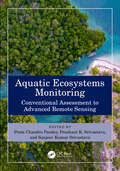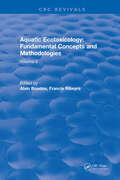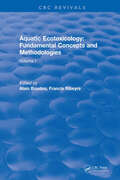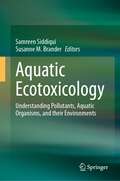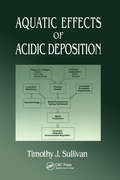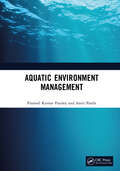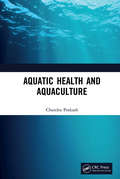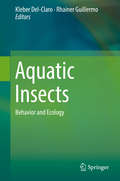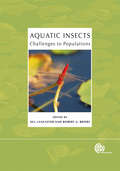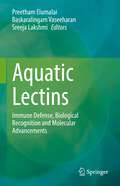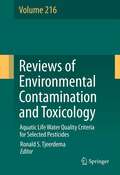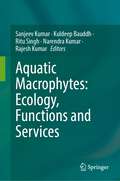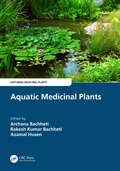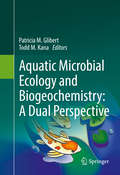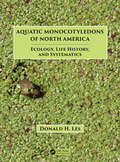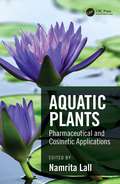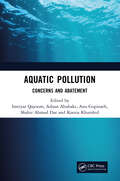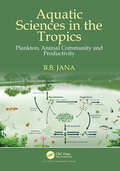- Table View
- List View
Aquatic Ecosystems Monitoring: Conventional Assessment to Advanced Remote Sensing
by Prem Chandra Pandey, Prashant K. Srivastava, and Sanjeev Kumar SrivastavaThis book collates traditional and modern applications of remote sensing in aquatic ecosystem monitoring. It covers conventional assessment methods like sampling, surveying, macroinvertebrates, and chlorophyll estimation for aquatic ecosystem health assessment. Advanced remote sensing technology provides timely spectral information for quantitative and qualitative assessment of water quality, shoreline changes, coral bleaching, and vegetation monitoring. The book covers different types of aquatic ecosystems like wetlands, rivers, lakes, saline, and the brackish lake. It also: Reviews the latest applications of remote sensing in the monitoring and assessment of aquatic ecosystems Includes traditional methods like cartography, sampling, surveying, phytoplankton assessment, river interlinking, and chlorophyll estimation Discusses the application of multi-source data and machine learning in monitoring aquatic ecosystems Discusses aquatic ecosystem management, services, threats, and sustainability Explores challenges, opportunities, and prospects of future Earth observation applications for aquatic ecosystem monitoring The book discusses space-borne, airborne, and drone geospatial data. The parts broadly cover aquatic ecosystem monitoring, vegetation management, advanced modeling practices, and challenges. It is meant for scientists, professionals, and policymakers working in environmental sciences, remote sensing, and geology.
Aquatic Ecotoxicology: Volume 2: Fundamental Concepts and Methodologies
by Alain BoudouResearch into ecotoxicology can be classified into three fundamental concerns: abiotic factors, which characterize the physicochemistry of environments; biotic factors, relating to biological structures and functions; and contamination factors, which define the modes of pollution of ecosystems. The most significant research methodologies currently being developed in aquatic ecotoxicology are presented, specifically experimental approaches in the laboratory
Aquatic Ecotoxicology: Volume 1: Fundamental Concepts and Methodologies
by Alain BoudouResearch into ecotoxicology can be classified into three fundamental concerns: abiotic factors, which characterize the physicochemistry of environments; biotic factors, relating to biological structures and functions; and contamination factors, which define the modes of pollution of ecosystems. The most significant research methodologies currently being developed in aquatic ecotoxicology are presented, specifically experimental approaches in the laboratory
Aquatic Ecotoxicology: Understanding Pollutants, Aquatic Organisms, and their Environments
by Samreen Siddiqui Susanne M. BranderThis textbook offers a basic understanding of aquatic ecotoxicology from molecular to physiological levels for graduate and advanced undergraduate students. The book covers the guidelines and lab protocols used by international organizations for ecotoxicology studies, and discusses the challenges faced by aquatic organisms in a changing climate from an ecotoxicological perspective. Readers will learn about pollutants, contaminants and chemicals of emerging concern (CECs) in aquatic environments, their impacts on environmental and human health, and what techniques can be used to curb and control their adverse impacts. The book will be useful for students in aquatic ecotoxicology, environmental pollution and marine biochemistry.
Aquatic Effects of Acidic Deposition
by Timothy J SullivanThe completion of the initial phase of the U.S. National Acid Precipitation Assessment Program (NAPAP) in 1990 marked the end of the largest environmental research and assessment effort to that time. The resulting series of 27 State of Science and Technology (SOS/T) Reports and the NAPAP Integrated Assessment represent a decade of work by hundreds
Aquatic Environment Management
by Pramod Kumar Pandey Amit PandeKey features – Covers different types of aquatic ecosystems like wetlands, rivers, lakes, saline, and brackish Reviews the latest applications of remote sensing in the monitoring and assessment of aquatic ecosystems Includes traditional methods like cartography, sampling, surveying, phytoplankton assessment and chlorophyll estimation Discusses the application of artificial intelligence, machine learning, data fusion in monitoring aquatic systems Explores the prospects of future Earth Observation space missions for aquatic ecosystem monitoring
Aquatic Environmental Bioengineering: Monitoring and Remediation of Contamination
by Rouf Ahmad Bhat Mohammad Yaseen Mir Gowhar Hamid Dar Moonisa Aslam DervashAquatic Environmental Bioengineering Discover the importance of remediation efforts for aquatic ecosystems Most contamination of water bodies stem from human activity, and the pollution in our water is one of the most important environmental concerns facing future generations. The most significant of these pollutants are halogenated organic compounds, petroleum hydrocarbons, radionuclides, metal and metalloids, pharmaceutical drugs, microbial toxins, and flame retardants. With such a vast array of potential contaminants and dangerously cumulating contamination levels in fragile marine environments, reparative action is more essential than ever. Aquatic Environmental Bioengineering: Monitoring and Remediation of Contamination provides the reader with a map towards environmentally safe and economically feasible technologies to intervene in polluted aquatic ecosystems. The authors suggest a phased approach consisting of site classification and risk assessment, followed by remediation technology selection and implementation. Effective methods for surveying bodies of water are particularly emphasized, and advancements in the development of novel transgenic plants and microbial fuel cells are put forward as effective tools against environmental contamination and industrial wastewater pollution. Readers will also find: A focus on the most recent and cutting-edge research on the topic: photocatalysis, the use of genetically modified organisms, and the use of nanomaterials A simple compendium of fundamental concepts in environmental engineering of aquatic ecosystems A detailed discussion of the advancement in remote sensing and geographic information (GIS), methodologies that make it possible to conduct large-scale water remediation studies at reasonable cost The ideal resource for researchers and students of environmental science, plant biotechnology, agricultural science, environmental engineering, and plant sciences, Aquatic Environmental Bioengineering will be a crucial resource for the remediation of contaminants in our aquatic ecosystems.
Aquatic Food Quality and Safety Assesment Methods
by R. Jeya Shakila G. JeyasekaranThe book explains on the methods and procedures adopted for testing the quality and safety of aquatic food products. The analytical techniques available for testing the chemical constituents of aquatic food with separate chapters on the analysis of lipids, proteins, vitamins, and minerals are exhaustively given to determine their nutritional quality. The various methods for sensory, physical, biochemical and microbiological quality assessments of aquatic food are explicitly given with detailed protocols for easy adoption. Special chapters covering the chemical contaminants and permitted additives for residue monitoring are dealt, as they are important food safety requirements. This book will be very helpful for the food quality control technologists, food analysts, research scholars, and fisheries professionals as a holistic guide on a variety of testing procedures for facile adoption to meet the food safety and quality regulatory requirements. Note: T& F does not sell or distribute the Hardback in India, Pakistan, Nepal, Bhutan, Bangladesh and Sri Lanka.
Aquatic Health and Aquaculture
by Chandra PrakashThis book discusses how to use the wastewaters, liquid biowastes and soils unfit for agriculture to economically viable aquaculture practices; and putting the emphasis on, aquaculture posology, the science of quantification and administration of doses in aquatic health and aquaculture management. Broadly, aquaculture practices come across three types of problems each; in the context of water quality, and fin fish and shell fish diseases; and preventive, curative and noncurative diseases in fin fish and shell fish. Note: T&F does not sell or distribute the Hardback in India, Pakistan, Nepal, Bhutan, Bangladesh and Sri Lanka.
Aquatic Insects: Behavior and Ecology
by Kleber Del-Claro Rhainer GuillermoThis book presents a broad view of the ecology and behavior of aquatic insects, raising awareness of this conspicuous and yet little known fauna that inhabits inland waterbodies such as rivers, lakes and streams, and is particularly abundant and diverse in tropical ecosystems. The chapters address topics such as distribution, dispersal, territoriality, mating behavior, parental care and the role of sensory systems in the response to external and internal cues. In the context of ecology, it discusses aquatic insects as bio indicators that may be used to assess environmental disturbances, either in protected or urban areas, and provides insights into how genetic connectivity can support the development of novel conservation strategies. It also explores how aquatic insects can inspire solutions for various problems faced by modern society, presenting examples in the fields of material science, optics, sensorics and robotics.
Aquatic Insects: Proceedings of the Royal Entomological Society’s 24th Symposium
by Jill Lancaster Robert A. BriersThis edited volume brings together acknowledged experts in often disparate fields ranging from physiology through ecology to evolution to consider in a unified manner the challenges facing insect populations in aquatic environments and how they have adapted to achieve such prominence in virtually all habitats.
Aquatic Lectins: Immune Defense, Biological Recognition and Molecular Advancements
by Preetham Elumalai Baskaralingam Vaseeharan Sreeja LakshmiThis book provides the latest information on fish lectins from the perspective of inflammation and presents new ideas on the complicated mechanisms of lectin biochemistry and associated interactions. Key features include discussion of mechanisms recently identified to be involving lectin family types, presentation of the latest evidence regarding the molecular approaches in fish lectins, and thorough explanation of the concept of antimicrobial and immunological roles and current understanding of the significance of its disease resistance related studies. Gene expression studies is another important element of the book, and it is proposed that gene editing technology provides gaining attention in the biological role of fish lectin research. Examples of the many lastest molecular approaches, applications and future perspectives in fish lectin specific topics covered in this book include the information right from the basics to the advancements in this area. The book will be a valuable update and resource for both experienced and younger researchers working in the field of lectins and immunology.
Aquatic Life Water Quality Criteria for Selected Pesticides (Reviews of Environmental Contamination and Toxicology #216)
by Ronald S. TjeerdemaReviews of Environmental Contamination and Toxicology attempts to provide concise, critical reviews of timely advances, philosophy and significant areas of accomplished or needed endeavor in the total field of xenobiotics, in any segment of the environment, as well as toxicological implications.
Aquatic Macrophyte Risk Assessment for Pesticides
by Lorraine Maltby Dave Arnold Gertie Arts Jo Davies Fred Heimbach Christina Pickl Veronique PoulsenGiven the essential role that primary producers play in aquatic ecosystems, it is imperative that the potential risk of pesticides to the structure and functioning of aquatic plants is adequately assessed. An integration of regulatory and research information from key specialists in the area of environmental regulation, Aquatic Macrophyte Risk Asse
Aquatic Macrophytes: Ecology, Functions and Services
by Sanjeev Kumar Kuldeep Bauddh Ritu Singh Narendra Kumar Rajesh KumarThis book is a comprehensive collection of information about the features, functions, and services of aquatic macrophytes. As primary producers, aquatic macrophytes form the basis of food webs, play a major role in highly productive aquatic ecosystems, and have a significant impact on ecosystem functions and services. Macrophytes are also known to strongly influence the micro-climate and biogeochemical processes occurring in the littoral zones of marine ecosystems and the sediment dynamics of freshwater systems. They also serve as highly effective carbon sinks and play an important role in carbon sequestration. This book deals with various aspects of aquatic macrophytes, including nutrient recycling, biogeochemical processes, biomass production, wetland ecosystems, water resource management, carbon sequestration, environmental clean-up, and bioenergy production. Additionally, it presents the current status of aquatic macrophytes and discusses the impact of climate change on these plants. The book also highlights the major challenges associated with harnessing the benefits provided by aquatic macrophytes as ecosystem services. The book holds value and relevance for academicians and scientists working in the related domain. Additionally, it will serve as a valuable resource for students and researchers working in the field of ecology, biogeochemistry, wetland conservation, phytoremediation, elements biomonitoring, wastewater management, bioenergy production, etc.
Aquatic Medicinal Plants (Exploring Medicinal Plants)
by Archana Bachheti Rakesh Kumar Bachheti Azamal HusenThe use of medicinal plants in herbal and modern medicine has gained popularity over the last few decades due to consumers taking more natural approaches to medicine. Aquatic medicinal plants are rich in bioactive compounds and demonstrate various commercial, nutraceutical, and biological applications. Aquatic Medicinal Plants offers the reader a wealth of information on uses of bioactive components of these plants, along with crucial references, and explains their traditional uses, phytochemistry, and pharmacological properties.Features Provides information on aquatic and semiaquatic medicinal plants and their uses globally. Discusses phytochemical components with the known active constituents and their pharmaceutical applications. This volume in the Exploring Medicinal Plants series is appropriate for scientists, experts, and consultants associated with the exploration of aquatic medicinal plant usage. This book is an essential tool for identifying important aquatic medicinal plants and possibilities for the synthesis or preparation of modern drugs.
Aquatic Mesocosm Studies in Ecological Risk Assessment
by Robert L. GraneyA Special Publication of the Society of Environmental Toxicology and Chemistry (SETAC)Aquatic Mesocosm Studies in Ecological Risk Assessment discusses the methods currently used for conducting simulated field studies and provides a series of case histories in which mesocosm type studies have been used to assess the impact of pesticides on aquatic ecosystems. Specific chapters address the dosing and exposure components of such studies and how they influence experimental design. Advantages and disadvantages of various statistical designs are addressed in detail. Regulatory aspects of the design and interpretation of these studies are also covered. The book will be a superb reference for aquatic biologists, ecologists, toxicologists, environmental toxicologists, environmental chemists, and regulatory personnel.
Aquatic Microbial Ecology and Biogeochemistry: A Dual Perspective
by Patricia M. Glibert Todd M. KanaThis book highlights perspectives, insights, and data in the coupled fields of aquatic microbial ecology and biogeochemistry when viewed through the lens of collaborative duos - dual career couples. Their synergy and collaborative interactions have contributed substantially to our contemporary understanding of pattern, process and dynamics. This is thus a book by dual career couples about dual scientific processes. The papers herein represent wide-ranging topics, from the processes that structure microbial diversity to nitrogen and photosynthesis metabolism, to dynamics of changing ecosystems and processes and dynamics in individual ecosystems. In all, these papers take us from the Arctic to Africa, from the Arabian Sea to Australia, from small lakes in Maine and Yellowstone hot vents to the Sargasso Sea, and in the process provide analyses that make us think about the structure and function of all of these systems in the aquatic realm. This book is useful not only for the depth and breadth of knowledge conveyed in its chapters, but serves to guide dual career couples faced with the great challenges only they face. Great teams do make great science.
Aquatic Monocotyledons of North America: Ecology, Life History, and Systematics
by Donald H. LesThis book brings together information on the natural history, ecology and systematics of North American aquatic monocotyledons. The book is an overview of the biology of major aquatic species by compiling information from numerous sources that lie scattered among the primary literature, herbarium databases, and other reference sources. Information on more than 300 species in 87 genera of monocotyledons will be included. Recent phylogenetic analyses will be incorporated. Although focusing specifically on North America, the cosmopolitan distribution of many aquatic plants should make this an attractive text to people working virtually anywhere outside of the region as well. Key Selling Features: The primary source of natural history information on aquatic plants Comprehensive lists of ecological associates Synthetic overview of systematic relationships of aquatic species and genera Practical information for rare and invasive plant managers Essential guide to facilitate wetland delineation
Aquatic Organic Matter Fluorescence
by Paula G. Coble Jamie Lead Andy Baker Darren M. Reynolds Robert G. M. Spencer Paula G. Coble Jamie Lead Andy Baker Darren M. ReynoldsThis is the first comprehensive text on the theory and practice of aquatic organic matter fluorescence analysis, written by the experts who pioneered the research area. This book covers the topic in the broadest possible terms, providing a common reference for making measurements that are comparable across disciplines, and allowing consistent interpretation of data and results. The book includes the fundamental physics and chemistry of organic matter fluorescence, as well as the effects of environmental factors. All aspects of sample handling, data processing, and the operation of both field and laboratory instrumentation are included, providing the practical advice required for successful fluorescence analyses. Advanced methods for data interpretation and modeling, including parallel factor analysis, are also discussed. The book will interest those establishing field, laboratory, or industrial applications of fluorescence, including advanced students and researchers in environmental chemistry, marine science, environmental geosciences, environmental engineering, soil science, and physical geography.
Aquatic Physiosphere-Biosphere Dynamics and Modelling: A Reference for Studies of the Coupled System
by Aike BeckmannThis encyclopedia is a reference for aquatic physical, biological and biogeochemical sciences, collecting and connecting a number of topics, concepts and facts about aquatic systems and their scientific investigation. The scope of the book comprises the aquatic physiosphere-biosphere transition zone, an entity that encompasses both inanimate matter and collectives (the physiosphere) as well as living organisms and collectives (the biosphere). This combined approach is meaningful because both realms are intimately linked and because available methods of investigation are often similar. Much can be gained from considering both spheres at and across their interface jointly, and while there is a strong focus on marine systems, most concepts presented are also applicable to freshwater systems. This presented snapshot of knowledge of the transition zone between the aquatic physiosphere and biosphere is taken from a very specific angle: the point of view of a modeler. Modeling is not only a state-of-the-art mode of scientific investigation, but also requires the explicit specification of all assumptions (helping to avoid fallacies), and offers the advantage of being quantitative and allows for theoretical "what if" scenarios.As in any reference work, equal emphasis is given to fundamental facts, the definition of terms and the explanation of concepts, in an attempt to establish a joint language for physicists, biologists and biogeochemists. Although originating from a modeler's approach to nature, the resulting suite of compatible concepts may also be useful beyond modeling purposes. Furthermore, the material is presented in a condensed, straightforward way. Hence, the length of each entry is limited to one (occasionally two) pages, thus offering a quick introductory overview. This excludes lengthy derivations and very specialized details. The book is geared towards researchers, teachers and advanced students in the field of aquatic (marine and limnic) sciences, in particular those interested or involved in interdisciplinary work.
Aquatic Plants: Pharmaceutical and Cosmetic Applications
by Namrita LallAquatic Plants: Pharmaceutical and Cosmetic Applications provides a concise description of popular aquatic plants found across the globe. The chapters in this beautifully illustrated, full-color book focus on the aquatic species native to specific continents. Written by a global team of experts, this book explains the distribution, ethnobotanical uses, genome sequencing, chemical compounds, and biological activity of these plants and addresses the cultivation and sustainable production of aquatic and wetland plants. Features: Describes the biological activity of a large collection of aquatic plants. Color photographs highlight each plant’s ethnobotanical characteristics, and structural formulae show their chemical constituents. Contributions come from leading scientists from countries including the United States, India, Mauritius, South Africa, and Cyprus. Aquatic Plants: Pharmaceutical and Cosmetic Applications is a valuable resource for academics conducting research on aquatic plants and for professionals in the pharmaceutical and cosmetic industries who are involved with the therapeutic applications of these plants and their sustainable usage.
Aquatic Plants of Pennsylvania: A Complete Reference Guide
by Timothy A. Block Ann Fowler RhoadsFrom the Delaware River to the shores of Lake Erie, Pennsylvania's diverse watery habitats are home to more than 200 species of aquatic plants. In Aquatic Plants of Pennsylvania: A Complete Reference Guide, botanists Timothy A. Block and Ann Fowler Rhoads have assembled the first identification guide specific to the Keystone State yet useful throughout the Mid Atlantic region. Organized and written in a way that will make information easily accessible to specialists and nonspecialists alike, the book highlights the diversity and vital ecological importance of this group of plants, providing photographs, illustrations, descriptions, and identification keys for all emergent, floating-leaved, and submergent aquatic plants found in the Commonwealth.An introductory chapter on aquatic plant ecology covers topics such as evolution, form, and reproduction of aquatic plants, vegetation zones, types of aquatic ecosystems, and rare and endangered species. Information on invasive plants, such as Eurasian water-milfoil and curly pondweed, that threaten Pennsylvania's aquatic ecosystems will be especially useful to watershed organizations, citizen monitoring projects, lake managers, and natural resource agency personnel. An illustrated identification key guides the reader through a series of steps to properly identify a specimen based on its characteristics. Each of the more than 200 listings provides a plant's taxonomy, detailed description, distribution map, and expert botanical illustrations. Many also include color photographs of the plants in their natural habitats.
Aquatic Pollution: Concerns and Abatement
by Imtiyaz Qayoom Adnan Abubakr Anu Gopinath Shabir A. Dar Keezia KhurshidThis book discusses the sources, mechanism, impact and abatement of pollution in waterbodies and lays a base foundation for further research. In this book, readers will also get acquainted with the methods of decontamination of lakes by phytoremediation, pesticide removal techniques from lakes, toxic site reclamation and environmental sustainability using microbial aspects associated with clean-up of wastes.Based on the issues related to pollution of aquatic environments, the subject matter of this book includes: Nanoplastic Pollutants Affecting Fisheries Sector All Over the World Freshwater Floral Diversities as Pollution Indicators Radioactive Waste: Sources and Impact on Environment Environmental Sustainability Using Microbial Aspects Associated With Clearing Up Waste Nitrates and Phosphates: Boon or Bane for Waterbodies Print edition not for sale in South Asia (India, Sri Lanka, Nepal, Bangladesh, Pakistan and Bhutan)
Aquatic Sciences in the Tropics: Plankton, Animal Community and Productivity
by B. B. JanaThe anatomy of water, water as a substance, water as a medium, the principles of the hydrologic cycle, the economics of water, and challenges are all covered in the first chapter of this book. The horizon of the tropical world, the environment, particularly the tropical environment, aquatic biome, tropical aquatic bionetwork, concept of biosphere, and tropical limnology are all covered in the second chapter. The third chapter covers the following topics: the origins of lakes, general lake classification, tropical lakes, lake morphometry, morpho-edaphic index, trophic status index of lakes, wetlands, and mangroves in tropical regions. The lotic environment is the main topic of the fourth chapter, which also covers the idea of stream order, the differences between rivers and streams, the river continuum, physical, chemical, and biological characteristics, and adaptations of fish found in hill streams. Chapter five covers the prokaryota, cyanobacteria, freshwater biota, and water-adapted organisms. The sixth chapter focuses on the algal communities Xanthophyceae, Euglenophyceae, Bacillariophyceae, Chrysophyceae, Phaeophyceae (brown algae), and Chlorophyceae. The seventh and last chapter covers the following topics: Protozoa, Porifera, Rotifera, Coelenterata, Annelida, Arthropoda, Crustacea, Aquatic Insects, Mollusca, Echinodermata, and Brachiopodaa.
